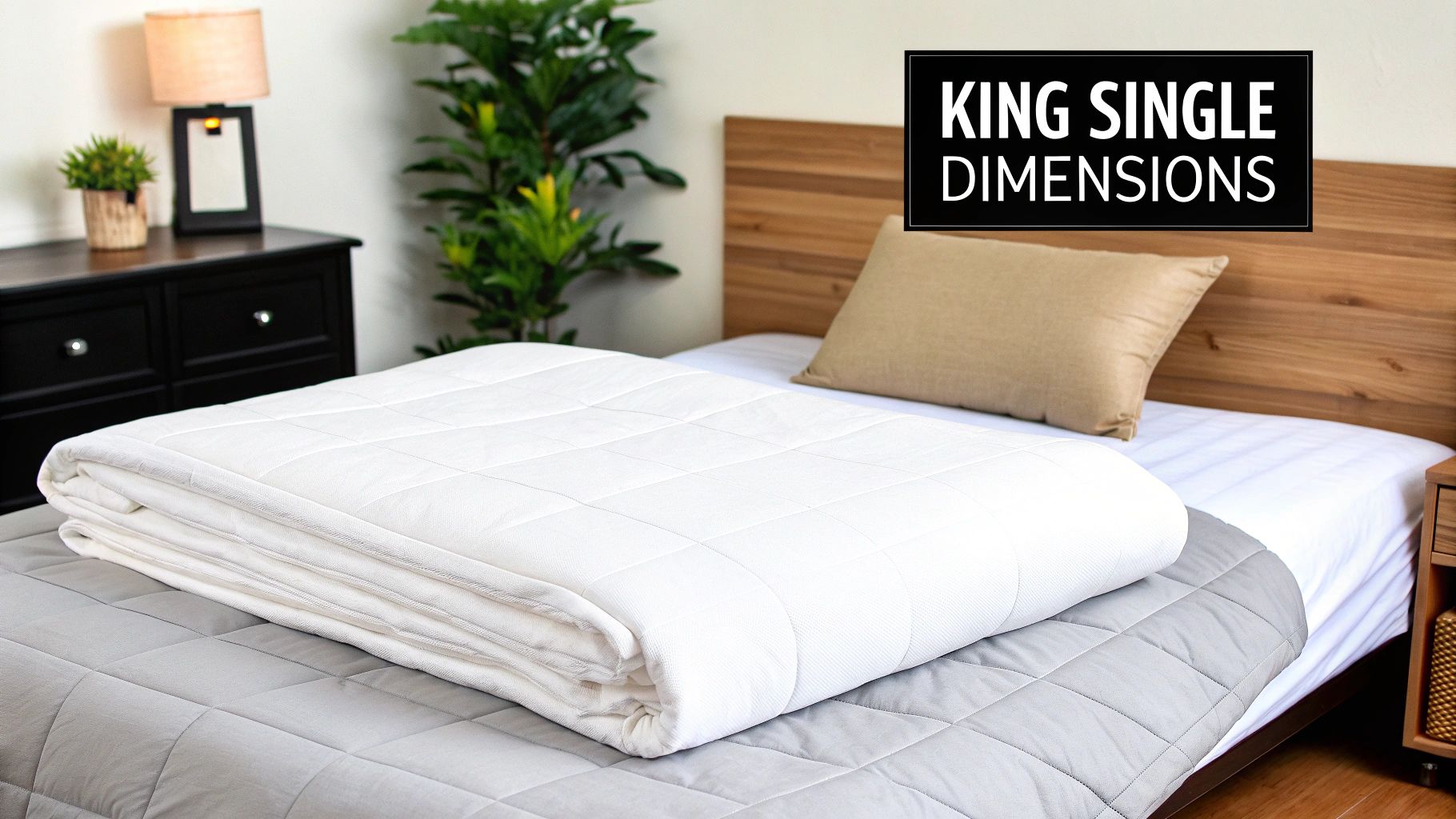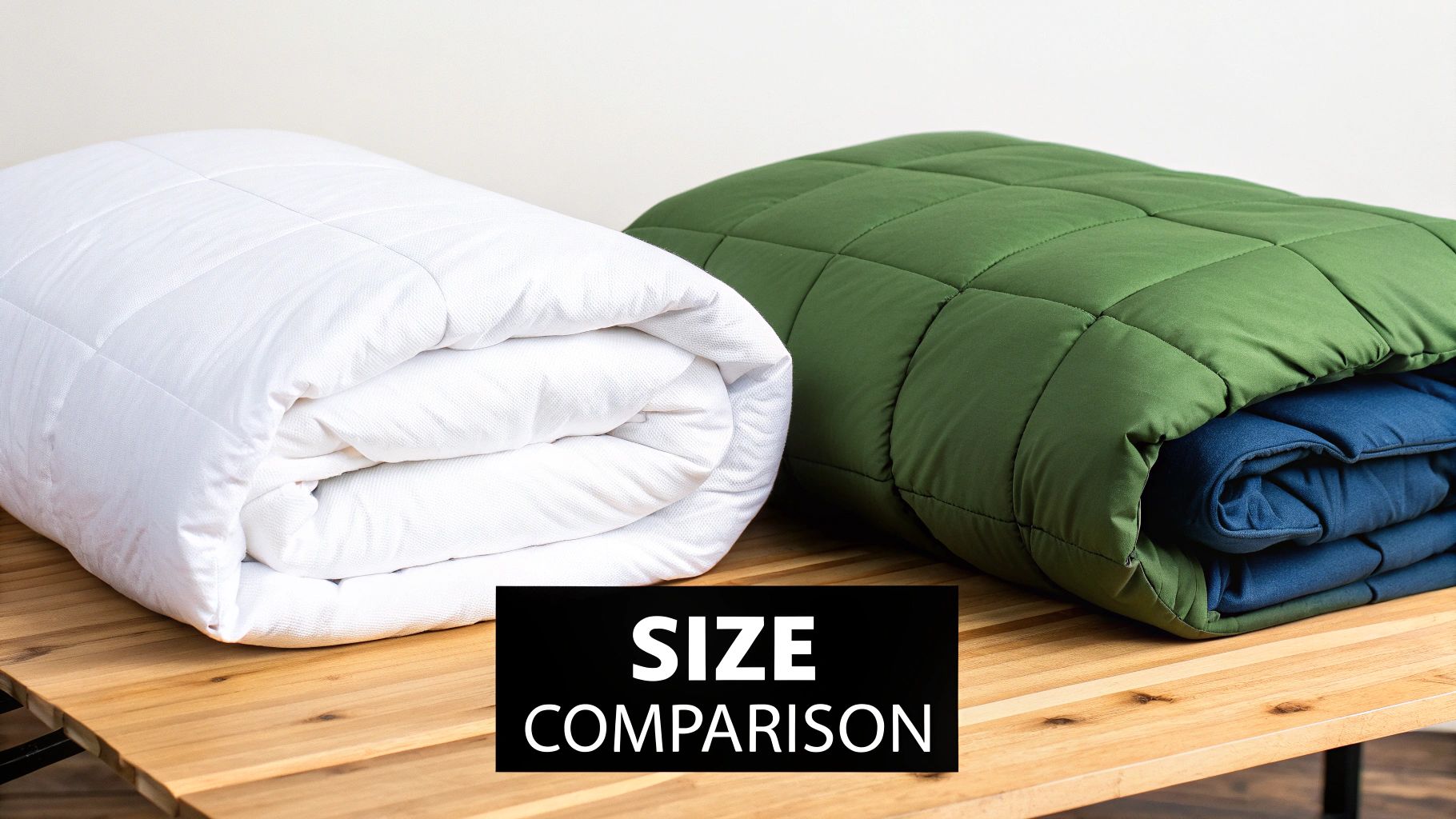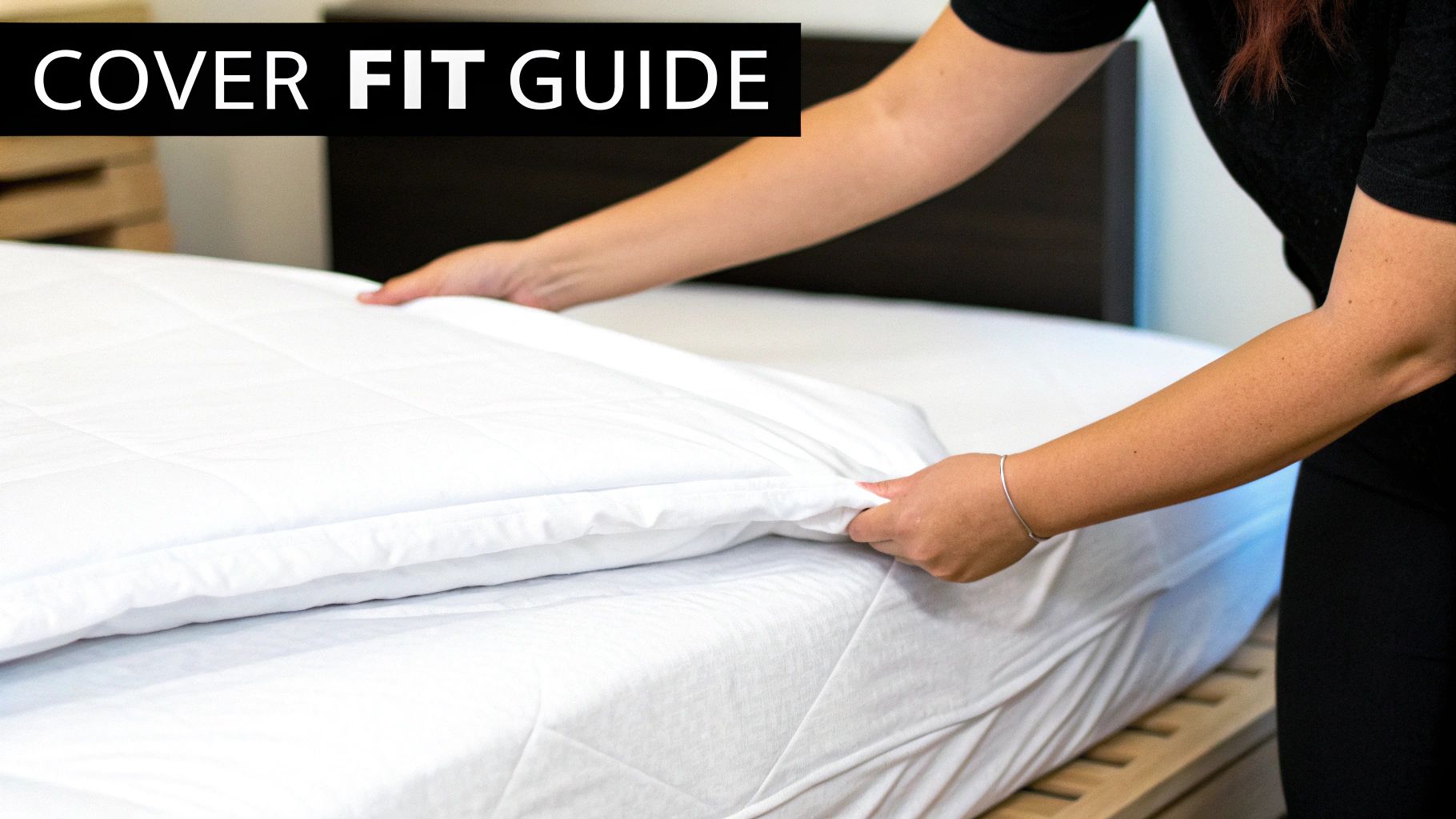Right, let's get straight to it. When you're looking for a king single duvet in New Zealand, the number you need to remember is 180cm x 210cm. That’s the standard size, and it’s been designed with a specific purpose in mind: to give you plenty of coverage on a king single bed, so you’re not left battling the cold in the middle of the night.
What is a NZ King Single Duvet Size, Exactly?

Trying to figure out bedding sizes can sometimes feel a bit like cracking a code. The name "king single" is a classic example—it sounds like a contradiction, but it actually describes a very practical and popular bed size here in NZ.
I always tell people to think of a duvet like a good winter coat for your mattress. Too small, and it's not going to do its job of keeping you warm. Too big, and it'll look sloppy and end up all over the floor. A king single duvet is sized just right, hitting that sweet spot between function and a beautifully made bed.
Why the Proportions Matter
It all comes down to the proportions. A standard NZ king single mattress is 107cm wide and 203cm long. This gives you a bit more length and width than a regular single, making it a fantastic choice for taller teenagers, single adults, or anyone who just appreciates a little more space to sprawl.
Because the mattress is bigger, the duvet needs to be bigger too. The 180cm x 210cm size is no accident; it’s designed to give you a generous amount of overhang—what we call the ‘drape’—on both sides and at the end of the bed. This isn't just about aesthetics; it's incredibly practical.
That extra drape is what keeps you cosy. It traps a pocket of warm air around you, acting as insulation against the cold. It also stops those annoying chilly drafts from creeping in whenever you roll over, which means a much better night's sleep.
NZ King Single Dimensions at a Glance
To make it even clearer, here’s a quick comparison of the mattress and its matching duvet.
| Item | Width (cm) | Length (cm) |
|---|---|---|
| King Single Mattress | 107cm | 203cm |
| King Single Duvet | 180cm | 210cm |
As you can see, the significant difference in width gives you plenty of duvet to cover the height of the mattress and still have enough to tuck in if you like a snug, neat look.
Getting these basics right is the first step to a comfortable and inviting bed. If you want to see how this size fits in with others, our complete guide to NZ duvet cover sizes is a great resource to explore.
Comparing King Single with Other Duvet Sizes
To really get a feel for why a king single duvet is the perfect match for its bed, it’s helpful to see how it stacks up against the other standard sizes you’ll find in New Zealand. Nailing the right size isn't just about making sure the bed is covered; it’s about getting that perfect blend of comfort, generous coverage, and great style. The wrong size can throw that whole balance off.
We've all been there. Picture a standard single duvet (usually 140cm x 210cm) on a king single bed. The length is spot on, but its narrow width means you’re in for a nightly tug-of-war. Every time you roll over, you're bound to feel a cold draught on your back because there’s just not enough duvet to drape over the sides.
The Problem with Going Too Big
On the flip side, you might think grabbing a double duvet is a smart workaround, but that often brings its own set of issues. While some double duvets in NZ share the same 180cm x 210cm size as a king single, many are wider. A duvet that's too big can easily overwhelm the bed frame, making it look sloppy and disproportionate.
The aim is to create a look that feels luxurious and intentional, not just messy. A duvet that’s too large can drag on the floor, picking up dust and becoming a trip hazard. It also makes the bed look out of scale with the rest of the room.
This is precisely what a purpose-made king single duvet is designed to avoid. It gives you plenty of overhang to keep you cosy without completely drowning the bed in fabric.
This visual guide shows how your choice of duvet size influences everything from material options to how you care for it.

The main point here is that veering off into non-standard or larger sizes can sometimes restrict your choice of materials and might even mean special trips to the laundromat. Sticking with the correct size just makes life easier.
A Quick Size Showdown
To put it all in perspective, let’s compare the standard NZ duvet dimensions. It quickly becomes clear why trying to mix and match sizes isn't the best path to a beautifully made bed.
- Single: Measuring 140cm x 210cm, it's just too narrow. You’ll definitely feel short-changed on coverage with this on a king single mattress.
- King Single: At 180cm x 210cm, this is your sweet spot. It provides the ideal amount of drape and warmth for a king single bed.
- Double: Often the same 180cm x 210cm, but sometimes wider. It can work in a pinch, but a wider version might spoil the clean lines of your bed.
- Queen: A 210cm x 210cm square, a queen duvet is far too big. It will completely swamp a king single bed, resulting in a messy, unbalanced look.
At the end of the day, sticking with the designated king single duvet size ensures your bedding is working with you, not against you. It’s the simplest way to guarantee you’ll stay warm and comfortable while achieving that polished, effortlessly stylish look every bed deserves.
Why the King Single Is So Popular in NZ Homes
The king single bed has well and truly earned its place in New Zealand homes, becoming far more than just another mattress size. It’s a clever, practical answer to the way we live now, perfectly striking that balance between personal comfort and the reality of our living spaces. Its popularity really is a mirror of the Kiwi lifestyle.

Just think about the different stages of life. For a growing teenager who’s shot up and outgrown their childhood bed, a king single gives them that crucial extra legroom and width. It does this without taking over the entire room like a double bed would, making it a perfect fit for the typical Kiwi kid's bedroom.
The same idea holds true for university students heading off to the halls or moving into their first flat. In these more compact living situations, every square metre is precious. The king single delivers a comfortable, adult-sized sleeping space while still leaving enough room for a desk, a chair, and a bit of floor space to move around.
The Sweet Spot for Single Sleepers
But it's not just for the younger crowd. Many single adults, especially those in city apartments or townhouses where space is at a premium, find the king single is the ideal compromise. It beautifully bridges the gap between a slightly restrictive single and a space-hungry double bed.
You get that lovely feeling of extra room to stretch out and get truly comfortable, all without having to sacrifice your entire bedroom floor plan. This growing focus on personal comfort is a huge trend; we’re all starting to realise that a great night's sleep isn't a luxury, it's essential. If you’re interested in this shift, you might like our article exploring why sleep is the new luxury.
The king single isn't just a bed size; it's a smart design choice. It recognises that for many New Zealanders, getting the most comfort out of a functional space is the ultimate bedroom goal.
A Strong Presence in the Market
You only have to look at the numbers to see how popular the king single really is. Industry insights show that around 25% of New Zealand households have a king single bed. It’s often chosen because it’s a perfect match for smaller bedrooms or for single sleepers who just want a bit more room to themselves.
Following that, the corresponding king single duvet size (180cm x 210cm) makes up a significant 18-20% of all duvet sales in the country. This really shows its solid footing in the market.
These are impressive figures, and they highlight just how many Kiwis have discovered this size is the ideal solution for their home. Whether it’s a child’s first “big bed” or a stylish and comfortable choice for the guest room, its versatility is hard to beat. The king single’s lasting popularity is proof that it meets the real-world needs of New Zealanders, delivering comfort right where it counts.
Choosing the Right Duvet Material and Fill
Getting the right size for your king single duvet is one thing, but what’s inside it is what really shapes how you sleep. The fill is the heart and soul of your duvet, dictating its warmth, weight, and even how you look after it. It’s all about finding the perfect match for your personal comfort and lifestyle.
Think of the fill as the engine of your duvet. Some are high-performance machines, delivering incredible warmth with barely any weight. Others are reliable workhorses, built for durability and easy care. Especially here in New Zealand, where the weather can turn on a dime, having the right engine is crucial for a good night's rest.
Getting to Know Your Fill Options
When you start looking, you’ll find that most duvet fills fall into two main camps: natural materials like wool and down, or synthetic alternatives like microfibre. Each one brings something different to the bed.
-
New Zealand Wool: This is a fantastic all-rounder, especially for our changeable Kiwi climate. Wool is a master of temperature regulation, keeping you wonderfully warm in winter yet cool and dry in summer by wicking moisture away from your body. A wool duvet has a bit more heft to it, giving you that comforting, reassuring feeling of being gently hugged.
-
Goose or Duck Down: If you’re after that classic “sleeping on a cloud” feeling, down is your go-to. It’s the champion of lightweight warmth, providing exceptional insulation without weighing you down. For anyone who wants to feel incredibly cosy without the bulk, a quality down duvet is a true investment in luxurious comfort.
-
Microfibre (Hypoallergenic): This is a brilliant and budget-friendly synthetic fill that’s designed to feel as soft and lofty as down. It’s a top choice for anyone with allergies, as it’s resistant to dust mites and super easy to pop in the washing machine.
A Quick Word on Loft and GSM You'll see these terms pop up on duvet packaging. 'Loft' (also called fill power) tells you how fluffy and insulating down is. A higher loft number means more warmth for less weight. 'GSM' (Grams per Square Metre) is used for wool and synthetic fills to measure their density. A high GSM like 500 is perfect for a toasty winter duvet, while a lower GSM around 200-300 is better for summer.
Making the Right Choice for Your Sleep Style
So, which one is for you? It really comes down to how you sleep.
If you’re someone who always feels the cold, the intense warmth of a high-loft down duvet might be your dream come true. On the other hand, if you tend to overheat, the natural breathability of NZ wool will be a game-changer. Think about how warm or cool your bedroom usually is and whether you prefer a light covering or a more substantial weight.
To help you decide, let's break down the options in a simple table.
Comparing King Single Duvet Fill Options
This table gives a quick comparative look at common duvet fill materials, helping you choose based on warmth, weight, and allergy considerations.
| Fill Material | Key Benefit | Best For | Allergy Friendliness |
|---|---|---|---|
| NZ Wool | Superior temperature regulation and breathability | Those who experience fluctuating temperatures; sleepers who like a heavier feel | Naturally hypoallergenic and resistant to dust mites |
| Goose Down | Unbeatable warmth-to-weight ratio; luxurious and lofty | Cold sleepers who prefer a lightweight, cloud-like feeling | High-quality, properly cleaned down can be suitable; look for anti-allergy casings |
| Microfibre | Affordable, easy to care for, and vegan-friendly | Allergy sufferers, children, and those on a budget | Excellent; can be washed frequently at high temperatures to eliminate allergens |
Ultimately, the best duvet inner is a deeply personal choice that will have a real impact on your nightly comfort. Your duvet is an investment in better sleep, so it’s worth taking a moment to pick the one that’s just right.
And of course, once you’ve chosen, looking after it is key. If you've paired your new duvet with beautiful linen, knowing how to wash linen sheets correctly will ensure your whole bedding setup stays looking and feeling incredible for years to come.
How to Style Your King Single Bed

Getting the king single duvet size right is the foundation, but styling is where you can really have some fun and bring your personality to life. A well-dressed bed does more than just look good; it can transform your bedroom from a simple sleeping space into a personal sanctuary. It all comes down to layering, playing with colour, and setting a specific mood.
To start, think about the overall vibe you're going for. Do you dream of that crisp, luxurious hotel finish or something more relaxed and lived-in? Your duvet is the main event. For a clean, tailored look, tuck the duvet in tightly around the mattress. If you prefer a softer, more casual feel, just let it drape naturally over the sides for that effortlessly cosy effect.
Building Height and Texture
The real secret to a bed that looks like it belongs in a magazine? Layers. A flat bed can look a bit sad and uninspired, but once you start adding different textures and heights, it instantly gains visual interest and a sense of plush comfort. This is where your pillows, cushions, and throws become your best friends.
Begin with your standard sleeping pillows, then prop two European pillows (the big square ones, usually 65cm x 65cm) upright against the headboard. They immediately add some vertical height, making the bed feel more substantial and inviting. From there, you can layer a few smaller, decorative cushions in front.
The trick with a king single is to add depth without making it feel cluttered. A good rule of thumb is two European pillows plus one or two smaller accent cushions. This creates that lovely layered look without overwhelming the bed's narrower frame.
A beautiful throw blanket is the perfect finishing touch. You can drape it artfully across the foot of the bed or fold it neatly for a more structured look. This is also a fantastic opportunity to introduce a new texture—think chunky knit wool against smooth cotton or a rich velvet to create a truly inviting, tactile experience.
Using Colour and Pattern Smartly
Your duvet cover is the biggest piece of fabric in the room, so its colour and pattern will have a major impact. Light, neutral tones like soft whites, natural linen, or gentle greys are brilliant for making a smaller room feel more spacious and airy. They help create a calm, restorative atmosphere.
On the other hand, if you want to make a statement, a duvet cover in a rich colour or a bold pattern can act as the stunning centrepiece of your room. To really tie everything together, you can even align your bedding choices with the latest interior design trends, ensuring your entire space feels cohesive and stylish.
Here are a few simple styling combinations to get you started:
- Minimalist & Calm: A natural linen duvet cover, two matching European pillows, and a single, textured lumbar cushion in the centre.
- Modern & Bold: A crisp white duvet provides a clean canvas for a richly coloured throw blanket draped across the bottom third of the bed.
- Luxe & Layered: A sateen or high-thread-count cotton duvet, two velvet European pillows, and an additional accent cushion in a complementary pattern.
By pairing the correct king single duvet size with a bit of thoughtful styling, you can easily turn your bed into an inviting focal point that you’ll love retreating to at the end of the day.
Your King Single Duvet Questions, Answered
Choosing the right bedding can feel surprisingly complicated. When it comes to king single duvets, a few key questions pop up time and time again. You want to get it right the first time, from size and fit to long-term care, so you can just enjoy a perfect night's sleep.
Let's clear up some of that confusion. Here are the straightforward answers to the most common queries we get, so you can feel confident you're making the best choice for your bedroom.
Can I Use a Double Duvet on a King Single Bed?
This is probably the number one question we hear, and the answer is a classic "it depends." Technically, you often can. Here in New Zealand, the standard king single duvet and a standard double duvet are frequently the exact same size: 180cm x 210cm.
So, if the dimensions match, it'll fit. The real question is about how it looks and feels. A duvet made specifically for a king single bed is designed to give you that perfect, elegant drape over the sides. Popping a slightly wider double duvet on there can sometimes create too much overhang, making the bed look a bit swamped or causing the duvet to drag on the floor. For that clean, well-proportioned look, sticking to a true king single size is usually the best bet.
Are Australian and NZ King Single Duvets the Same Size?
No, and this is a really important one to watch out for! It’s a common trap for shoppers and can easily lead to a frustrating mistake if you’re not paying attention.
- NZ King Single Duvet: 180cm x 210cm
- Australian King Single Duvet: 160cm x 210cm
That’s a full 20cm difference in width. An Aussie king single on an NZ bed will look skimpy, leaving very little drape down the sides. More than just aesthetics, it means less cosy coverage and potentially a chilly night's sleep. Always, always check the dimensions on the packaging and, to be safe, buy from a New Zealand retailer to guarantee you’re getting the right fit for your bed.
Here's a simple rule of thumb: measure your mattress first, then check the duvet's dimensions on the label before you buy. This little step takes all the guesswork out of it and ensures you get that generous, comfortable coverage you’re after.
How Should I Wash My King Single Duvet?
Looking after your duvet properly is the secret to making it last, but how you do it comes down to what it's made of. The care tag is your bible here—always check it before you do anything else.
If you’ve invested in a natural fill like wool or goose down, professional laundering is generally the safest route. This prevents the delicate filling from clumping or getting damaged. For a quick refresh at home, simply airing it outside on a dry, breezy day works wonders.
Most duvets with synthetic microfibre fill are much easier to handle and can be washed at home. You’ll just need a large-capacity washing machine. Use a gentle, warm cycle with a mild detergent. To dry, tumble dry on low and throw in a few wool dryer balls—they’re brilliant for fluffing up the filling and making sure it dries evenly, preventing any chance of mildew.
At The Foxes Den, we believe real luxury is found in the small details—from getting the size just right to choosing materials that bring you comfort year after year. Take a look at our curated collection of premium bedding and start creating your own sleep sanctuary.


